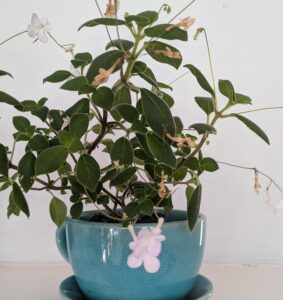 I am a romantic at heart, so I never could have imagined that I would fall madly in love with a plant that sounds like a fairy tale/throat infection mash-up. The plant in question—and the object of my current crush—is Streptocarpella ‘Dancing Doves’. The affair is so successful that I rooted a cutting from the ‘Dancing Doves’ plant that I bought last spring and will soon present the offspring to my plant-loving daughter.
I am a romantic at heart, so I never could have imagined that I would fall madly in love with a plant that sounds like a fairy tale/throat infection mash-up. The plant in question—and the object of my current crush—is Streptocarpella ‘Dancing Doves’. The affair is so successful that I rooted a cutting from the ‘Dancing Doves’ plant that I bought last spring and will soon present the offspring to my plant-loving daughter.
If you have ever grown a streptocarpus, or cape primrose, you will recognize the flowers of streptocarpella, which also sometimes goes by the names “nodding violet,” or “false African violet”. The blooms are about 1.5 inches long and wide and look like miniature streptocarpus blossoms. For those who don’t know any of the “streptos”, the violet-like flowers consist of three large lower petals and two small upper petals, all fused at the bases to form elongated tubes. The tubes connect to wiry stems that in turn connect to hollow green stalks. The leaves on those stalks mark a point of divergence from the cape primroses. ‘Dancing Doves’ and other streptocarpellas bear medium green leaves that are opposed on the stems. Streptocarpus, by contrast, features long, heavily veined leaves. As is the case with many gesneriads, streptocarpella leaves are a little pubescent or fuzzy in texture. Each is two to three inches long and roughly ovoid, with pointed ends.
The streptocarpellas grow eight to 12 inches tall, with a spread of 12 to 15 inches. They boast a branching, sprawling habit, with the stalks surging out in all directions. This makes the the little “streptos” an excellent choice for window boxes, tall plant stands, or hanging baskets. Because the flowers are on wiry stems, the effect is light and airy. ‘Dancing Doves’ bears lovely white flowers, and produces them in profusion, with rebloom happening regularly.
The streptocarpella genus, along with that of its cousin, streptocarpus, is part of the large Gesneriaceae or African violet family, and, in fact, at least one source mentions that those tried and true windowsill stalwarts, African violets, formerly known as saintpaulia, have been moved by taxonomists into the streptocarpella genus. Taxonomists will, no doubt point to all the genetic and scientific reasons for doing so. I think that as a group, plant taxonomists are easily bored and love confusing ordinary plant lovers.
I bought my ‘Dancing Doves’ plant as a small, hanging basket, and after six months, it needs larger quarters. That six month spell included time spent outdoors in a shaded spot. Like most of the gesneriads, streptocarpellas are native to tropical areas, and are not cold-tolerant. This trait is actually a blessing in disguise because the plants will bloom during the dark months, when many tropicals are heavily involved in semi-dormancy.
Because ‘Dancing Doves’ has been so successful, I may seek out a second streptocarpella. The choices are few, but Proven Winners offers a blue-purple variety, dubbed ‘Concord Blue’. It is billed as Streptocarpella saxorum, but may well by a hybrid, just like ‘Dancing Doves’. This confusion between species and hybrid plants exists throughout the horticultural industry, but should not be a worry. Generally whether the plant is a species or hybrid variety, the characteristics are very similar. Frequently the species is a parent or genetic relative of the hybrid.
All of that is useful to know and may come in handy if you feel the need to bore obnoxious people in social gatherings. What is more important is taking proper care of your “strepto”. Fortunately, that is relatively easy, and is almost identical to caring for an African violet. The plants generally like a sunny windowsill inside, or a shaded, protected spot outside. Water carefully; avoiding water drops on the leaves, which cause unsightly spotting. Special gesneriad or African violet fertilizers are available, but if you don’t have any handy, use a houseplant fertilizer, diluted, if necessary, according to manufacturer’s directions.
If you are ready for a new houseplant love affair, and want to try streptocarpella, it may take a bit of effort to find one. Some garden centers and nurseries may stock them in their greenhouses, and it pays to ask. If you can’t find one locally, try Etsy online. Several small growers offer the plants for sale. The Gesneriad Society also maintains a list of suppliers of the various species and hybrids in the Gesneriad family, and some of those businesses may carry streptocarpellas. Find the list at https://gesneriadsociety.org/resources/gesneriad-suppliers/.
